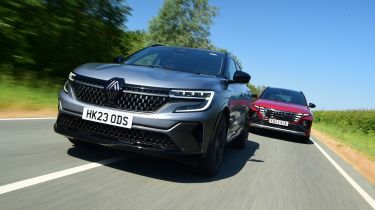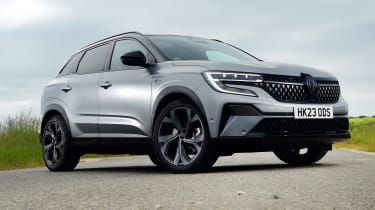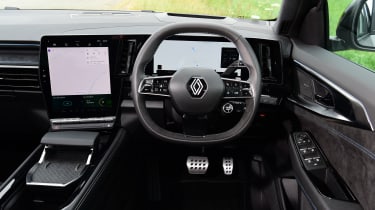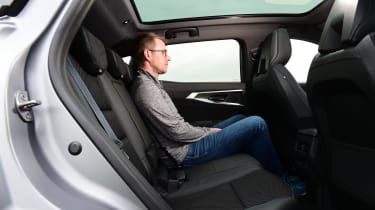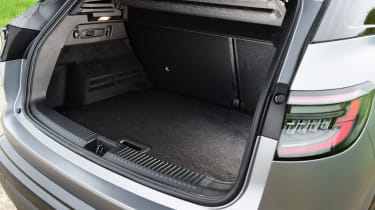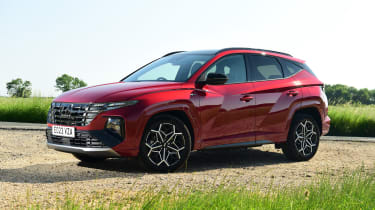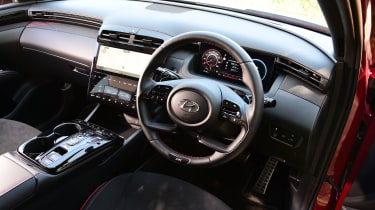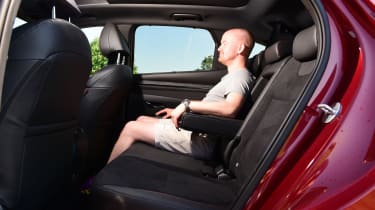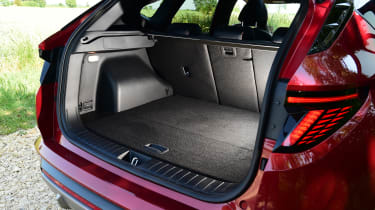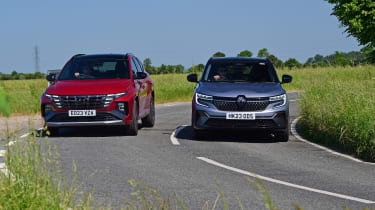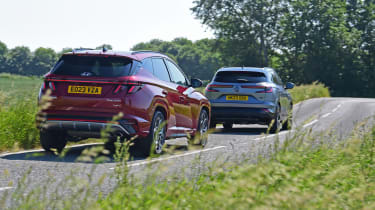Renault Austral vs Hyundai Tucson: 2023 twin test review
The all-new Renault Austral takes on the class-leading Hyundai Tucson
The family SUV segment is one of the most lucrative in the UK, with three of the best-selling cars so far in 2023 coming from that class. It’s a sector which Renault hasn’t played a part in since it dropped the capable but ageing Kadjar in 2022.
But that’s all changing with the new Austral. It has almost nothing in common with its predecessor, and our first impressions confirm that it’s taken a huge leap forward across the board – including in efficiency, because the Austral is hybrid only. But can it compete with the class best?
We’ve brought along one of its strongest class rivals for comparison, the Hyundai Tucson. It’s a car which not only covers all the usual family car bases, but also happens to look genuinely desirable. And as with the Renault, it’s available with a full-hybrid powertrain.
|
Renault Austral E-Tech Hybrid Iconic Esprit Alpine |
Hyundai Tucson Hybrid N Line S | |
|
Price: |
£39,495 |
£39,005 |
|
Powertrain: |
1.2-litre 3cyl turbo hybrid, 197bhp, front-wheel drive |
1.6-litre 4cyl turbo hybrid, 227bhp, front-wheel drive |
|
0-62mph: |
8.4 seconds |
8.0 seconds |
|
Test efficiency: |
43.0mpg/9.5mpl |
39.9mpg/8.8mpl |
|
CO2: |
105-110g/km |
131g/km |
|
Annual VED: |
£170 |
£170 |
Renault Austral
The Austral tested here is in top-spec Iconic Esprit Alpine trim. It’s priced at £39,495.
Tech highlights
As the successor to the Renault Kadjar – a car which in its day was a class leader in the segment – the Austral has plenty to live up to. On paper at least, it appears to have taken a huge step forward when compared with its predecessor.
Used - available now

2020 Land Rover
Discovery Sport
24,114 milesAutomaticDiesel2.0L
Cash £25,960
2023 Tesla
New Model Y
20,490 milesAutomaticElectric
Cash £26,697
2021 Audi
Q3
55,755 milesAutomaticPetrol2.0L
Cash £20,197
2020 Jeep
Compass
70,901 milesManualDiesel1.6L
Cash £11,197The CMF-CD platform is shared with the latest Nissan Qashqai and X-Trail, plus the Europe-only Renault Espace. It allows for the integrating of electrified powertrains, and Renault has given the Austral a full-hybrid system. This combines a 1.2-litre, three-cylinder turbocharged petrol engine with an electric motor – the former makes 129bhp and 205Nm, the latter 67bhp and the same 205Nm.
While that sounds fairly conventional, what’s unique about the powertrain comes in the shape of the transmission. It provides two speeds for the electric motor and a further four for the combustion engine, allowing for a range of ratio combinations. Electrical energy is supplied by a 2kWh battery, which can be charged both by regenerative braking and also by the combustion engine acting as a generator.
Our Iconic Esprit Alpine test car comes with four-wheel steering that slashes the turning circle to 10.1 metres, which is less than a Clio’s. Without it, the turning circle is 11.4 metres.
Safety: Renault boasts of up to 30 advanced driver-assist systems on board the new Austral, with some upgraded over previous Renaults. Its lane-centering tech can maintain road position even if obvious markings are missing on one side of the road, such as on a country lane. As a result, the Austral chalked up a maximum five-star safety rating from Euro NCAP in 2022.
On the road
There are strong points to the way the Austral drives, but there are compromises, too. The hybrid powertrain sometimes feels too complex for its own good, and the chassis tuning needs some work.
Around town: The Austral defaults to pure-electric mode when moving off, so it’s incredibly smooth when shuffling along in traffic. Less so is the ride, which constantly fidgets over bumps and broken road surfaces. The steering is light, though, and the tight turning circle makes the Renault brilliant to manoeuvre at low speeds.
A & B-roads: That steering doesn’t offer much confidence when you increase your pace. The last Renault to use four-wheel steering was the Renaultsport Megane, which had a delay between the front wheels turning and the rear steering reacting, and the Austral has the same problem.
It gives the impression that the rear end is about to lose grip, and this is magnified by the fact that the reaction of the steering is too fast for the body control. It means that keen turn-in causes the car to lurch on its springs, unless you’re exceptionally precise and deliberate with your inputs.
The hybrid system isn’t perfect, either. While noise levels are low (the engine is quiet under hard acceleration) the gearbox is often confused. Ask for some urgency when pulling on to a roundabout or overtaking, and there are a few stabs of acceleration before the gearbox finally settles on a ratio.
Motorway: High-speed refinement is compromised by that persistently fidgety ride, but wind noise is also an issue. Even from 50mph, we noticed quite pronounced rustling coming from the door mirrors; at 70mph the Austral was much less refined than the Hyundai.
Ownership
Renault has been on form recently when it comes to cabin design. The Clio and electric Megane E-Tech manage to look fresh, and are towards the top of their classes when it comes to fit and finish. The Austral gets soft-touch plastics dotted around its interior, while the Alcantara-like panels on the dash and doors add a plusher texture.
The bank of physical climate control keys below the main touchscreen is easy to use, too, but the passenger-side air vent felt flimsy and had broken already. The high driving position gives a great view of the road ahead, while the slightly squared-off steering wheel, trimmed in a mix of leather and Alcantara, is great to hold.
Renault offers a three-year warranty across its range, although this is shorter than the five-year package it offered up until 2020. However, three years’ breakdown cover is a more generous offer than many of its rivals, including the Tucson.
In the 2023 Driver Power Manufacturer rankings, Renault took a lowly 29th position out of 32 brands. Of those surveyed, 25 per cent of Renault drivers experienced one or more faults with their vehicles, and over half of those drivers reported electrical gremlins.
Storage: The Austral features plenty of cubbies inside. The front door bins are generous, with an official capacity of 4.3 litres, and space for a large bottle within them. The rear door bins are a little smaller, at 2.1 litres, but largest of all is the glovebox, which Renault says has 6.4 litres of capacity. However, we found that it was quite deep, and doesn’t curve away into the footwell like many gloveboxes, to the detriment of front kneeroom.
The centre console features a sliding panel which has a wireless phone charger on top, and a place to rest your hand when using the touchscreen. Slid forward, it reveals a deep bin, while in its rearmost position it opens up space for a pair of cup-holders.
Practicality
While the Austral’s cabin has some neat touches, it can’t quite match the overall load capacity of its rival.
Rear Space: All versions of the Austral come with a sliding rear bench. The 60:40 split allows either section to move back and forth by up to 160mm independently of the other, so either boot space or kneeroom can be prioritised. With the bench as far back as it goes, kneeroom is generous. The outer seats are quite sculpted and supportive.
Boot: Getting items into the back of the Austral might be difficult; a boot lip height of 805mm is among the highest we’ve measured in any new car.
Renault only quotes a boot capacity for the Austral with the back seats moved as far forward as they can go. Even in this position, the 555 litres on offer is 61 litres down on the Hyundai.
What to buy?
Which engine and trim we’d choose
- Engines: There’s just a single hybrid powertrain in the Austral. By contrast, the Tucson is offered with PHEV and conventional petrol options, too.
- Trim: Techno starts from £34,695. Techno Esprit Alpine adds a powered tailgate plus a heated steering wheel and front seats (among other things) for £2,000 more, and the Iconic Esprit Alpine adds a 360-degree camera, a panoramic roof and wireless phone charging for £39,495.
- Options: Paint is the only option. All Iconic Esprit Alpines come with a black roof – our car’s Matte Shadow Grey is £1,900.
- Our choice: Techno Esprit Alpine offers the best balance between price and kit.
Hyundai Tucson
We’re testing the Tucson here in N Line S trim which, at £39,005, just dips under the Austral’s price to the tune of £490.
Tech highlights
The Hyundai Group’s N3 architecture forms the basis of the Tucson. The platform is also shared with the larger Santa Fe, plus the Kia equivalents: the Sportage and the Sorento.
As with the Austral, the Tucson is powered by a mix of petrol and electric energy sources. While they fundamentally operate in the same way, the main difference between the two is that the Hyundai is equipped with a more conventional dual-clutch gearbox.
The combustion element of the powertrain is larger, with the Tucson’s unit offering 399cc and an extra cylinder over its rival. But it needs this to compensate for the fact that the electrical side of the Tucson’s hybrid tech is slightly behind the Renault’s. Both its 1.49kWh battery and 59bhp motor fall slightly short, although the latter does fight back with a generous 265Nm of torque, which is 60Nm more than the Austral can muster up in electric mode.
Combined, the Tucson’s stats have the Renault beaten. At 227bhp and 350Nm, it’s 30bhp and 95Nm ahead of its newer rival. However, the Tucson needs that extra punch, because it weighs 58kg more than the Austral.
Safety: Like the Austral, the Tucson is a five-star car in the eyes of Euro NCAP, and it was tested in 2021. The N Line S model builds on the safety spec of the base trim levels with features such as rear cross-traffic alert and avoidance, forward-collision avoidance that can detect hazards when turning out of junctions, and blind-spot warning.
On the road
The Tucson won’t set any drivers’ pulses racing, but it’s composed, refined and feels exceptionally solid – qualities that all really matter for a trustworthy family car.
Around town: With an electric motor taking care of low-speed driving, the Tucson is very smooth when shuffling along in traffic or parking. The engine tends to offer assistance more often than in the Renault, though, and when it does, it’s more audible. The steering is a little heavier than the Austral’s, and the rack is slower, which means it doesn’t feel quite as nippy in town.
A & B-roads: That more relaxed response comes into its own on more open roads. Nothing else in this class feels as stable and reassuring as the Tucson. The steering is slow, but it’s pleasingly precise, and body roll is kept in check much better than in the Austral, even though the Tucson rides more comfortably over broken surfaces.
There’s a very occasional jolt over sharper bumps, but it’s by far the more relaxing car here. It’s certainly not what you’d call fun – but it’s as agile as it needs to be and is set up to avoid nasty surprises.
One surprise is how raucous the engine is. The four-cylinder unit helps to contribute to a 0-62mph time of eight seconds – 0.4 seconds faster than the Renault – but it sounds coarse at high revs.
Motorway: It’s a shame that the engine sound is so rough, because it’s the only part of the Tucson driving experience that lets the side down. High- speed refinement and stability are class leading, with road and wind noise kept in check much better than in the Renault. The ride remains composed, too, making the Hyundai a great car in which to cover large mileages.
Ownership
The solid feeling that the Tucson shows out on the road is mirrored by the feeling you get inside its cabin. The centre of the dashboard is laid out in one monolithic slab that houses both the ventilation and heating controls, the vents themselves and the infotainment display.
This flows into a curvier design to either side, while fabric trim across the dash – which in N Line S trim includes some red flashes – breaks up the plastic. The quality feels excellent for the class, and the physical switchgear works well. Even the parts that are touch-sensitive – such as the climate controls – are neatly laid out, with enough space between the keys so that they’re easy to use on the move. The driving position is high and gives a great view ahead over the low dashboard line.
In the latest 2023 Driver Power survey, Hyundai took 17th place out of the 32 brands covered. Not only did it beat Renault in the overall rankings, but fewer owners also experienced faults. Even if something goes wrong, you’ll have Hyundai’s five-year warranty to fall back on. It offers cover for an unlimited mileage, which is ideal if you’re looking to cover long distances and plan to own the car for a long time.
Storage: A pair of deep cup-holders sit within the centre console, and thanks to the neatly grouped buttons for the gear selector, they don’t obstruct any of the major controls while driving. Behind it sits a deep storage bin beneath the central armrest, and ahead of it there’s a shelf for holding a smartphone.
The glovebox is a decent size, if not quite as big as the one you get in the Austral, while the rear door bins aren’t particularly large, either.
The Isofix points are a little awkward to get to between the seat cushions. We much prefer the Renault’s, which are easy to reach behind folding plastic covers. It’s a shame that the Tucson doesn’t have any sturdy bag hooks in the boot, either.
Practicality
The Tucson matches the Austral when it comes to passenger accommodation, but it has a bigger boot.
Rear Space: Kneeroom in the Tucson is similar to that in the Renault’s back seats, but the Hyundai marginally beats its rival on both headroom and cabin width. The seats themselves are supportive, and the squabs are high enough above the floor to provide plenty of under-thigh support for taller adults. Foot space beneath the front seats is also plentiful.
Boot: It’s at the back where the Hyundai has the biggest advantage. At 616 litres, the Tucson’s load space is much larger than its rival’s – especially if you slide the Renault’s bench back. Fold the seats down and the gap between the two grows, with the Tucson able to carry 1,795 litres to the Austral’s 1,455 litres.
What to buy?
Which engine and trim we’d choose
- Engines: In addition to the full-hybrid powertrain we have here, the Tucson comes with a 1.6-litre turbo petrol with either 148bhp or 178bhp, plus there’s a plug-in hybrid model with 261bhp.
- Trim: There are five trim levels to choose from. SE Connect kicks things off from £34,640, and the range tops out with the £39,585 Ultimate.
- Options: It’s worth looking through the trim levels thoroughly, because there aren’t any option packs you can add once you’ve made your choice – just a range of exterior colours.
- Our choice: Premium spec saves you £2,000 over N Line S, yet comes loaded with kit.
Results
Which car comes out on top?
Winner: Hyundai Tucson
The Tucson is proving a tough car to beat in this segment, and once again it has managed to see off a newer rival. Its mix of space and style puts it on a very strong footing, but it backs that up with a smooth ride, impressive refinement (engine note aside), solid safety ratings and a cabin that’s more than spacious enough for family life.
The Renault uncovers some chinks in the Tucson’s armour – most notably that it could be a little cheaper to run – but it’s not enough to overturn its strengths elsewhere.
|
Pros |
Cons |
|
Impressive refinement |
Not the most fun to drive |
|
Comfortable cabin |
Rough engine note |
|
Strong residual values |
Not as frugal as the Renault |
|
Large boot |
Runner up: Renault Austral
The new Austral has moved the game on from the Kadjar it replaces, but unfortunately for Renault, rivals like the Tucson have made even bigger strides forward in that time.
If infotainment tech is high up your list of priorities, then no other car in this class does it better, while strong economy and low running costs are areas where the Austral excels. If Renault could introduce a more relaxing chassis set-up and smoother hybrid tech, it would compete with the very best.
|
Pros |
Cons |
|
Brilliant infotainment tech |
Clunky gearbox |
|
Versatile seating |
Fidgety ride |
|
Impressive fuel economy |
Road noise |
|
Generous standard kit |
Unnerving four-wheel steering |
Rivals and other options
- Same money: Skoda Superb Estate
- Same class: Toyota RAV4
- Used: Audi Q4 e-tron
- Used: BMW X3
- Coming soon: Honda ZR-V
The great debate
What the Auto Express test team would do…
Sean Carson, associate editor: “The fact that the Austral’s ride is so fidgety is a disappointment, because there’s definitely a capable car in there somewhere. We’re keen to try it in Techno spec to see if the smaller wheels and torsion-bar rear suspension have any effect on the way that the car behaves.”
John McIlroy, deputy editor: “After the impressive Megane E-Tech, we were hoping for just a little bit more from the Austral, especially in the handling department. Renault has plenty of form when it comes to developing a keen and capable chassis, but on this occasion it seems like it’s been a little too clever for its own good.”
Dawn Grant, picture editor: “Hybrid tech is all well and good, but the mpg figures we achieved aren’t exactly sparkling. Our Skoda Karoq TDI long-term test car run by photographer Pete Gibson is achieving very similar results. It also has bags of torque, too. For certain types of car, there’s still a little more life in diesel yet.”
Steve Fowler, editor-in-chief: “If the Tucson’s looks aren’t quite your cup of tea, then the Kia Sportage might be an option. It’s nearly identical under the skin, with the same hybrid tech, albeit in a chassis that trades just a little comfort for agility. The kit list is just as strong, and it gets a seven-year warranty, too.”
Dean Gibson, senior test editor: “One key advantage that the Tucson has over the Austral is powertrain choice. The Benefit in Kind-busting PHEV has a 13.8kWh battery that offers an electric range of 38 miles, while low CO2 figures place it in the 12-per cent company car tax band.”
What would you do? Let us know in the comments section below…
Specs and prices
| Renault Austral E-Tech Hybrid Ionic Esprit Alpine | Hyundai Tucson Hybrid N-Line S | |
| Petrol or diesel | Petrol | Petrol |
| MPG (WLTP) | 43 | 39.9 |
| Fuel price | £1.43 | £1.43 |
| P11D value | £35,255 | £38,705 |
| Fill up | £78.87 | £74.57 |
| On the road price/total as tested | £39,495/£41,395 | £39,005/£39,670 |
| Residual value (after 3yrs/36,000) | £22,824 (57.79%) | £23,490 (60.12%) |
| Depreciation | £16,671 | £15,555 |
| Annual tax liability std/higher rate | £1,833.26/£3,666.50 | £2,399.71/£4,799.40 |
| Annual fuel. cost (10k/20k miles) | £1,516 (£3,032) | £1,634 (£3,268) |
| Ins. group/quote/VED | 23/£700/£170 | 23/£685/£170 |
| Service costs (3 years) | £0 | £627 |
| Length/wheelbase | 4,510/2,667mm | 4,500/2,680mm |
| Height/width | 1,644/1,825mm | 1,653/1,865mm |
| Engine | 3cyl in turbo/1,199cc | 4cyl in turbo/1,598cc |
| Peak power | 197bhp | 227bhp |
| Peak torque | 255Nm | 350Nm |
| Transmission | Multimode auto/fwd | Six-speed auto/fwd |
| Fuel tank capacity / spare wheel | 55 litres/repair kit | 52 litres/repair kit |
| Boot capacity (front / seats up/down) | 555/1,455 litres | 616/1,795 litres |
| Kerbweight/payload/towing weight | 1,627/526/1,500kg | 1,685/490/1,650kg |
| Turning circle | 10.1 metres | 10.9 metres |
| Basic warranty/recovery | 3yrs (60,000)/3 yrs | 5 yrs (unlimited)/1 yr |
| Driver Power manufacturer position | 24th | 17th |
| Euro NCAP: Adult/child/ped./assist/stars | 88/83/69/87/5 (2022) | 86/87/66/70/5 (2021) |
| 0-62mph/top speed | 8.4secs/108mph | 8.0secs/120mph |
| Test economy / range | 43mpg/520 miles | 39.9mpg/456 miles |
| WLTP combined | 60.1mpg | 48.7mpg |
| Actual/claimed CO2/tax bracket | 152/105g/km / 0.26 | 161/134g/km / 0.31 |
| Number of airbags/Isofix points | Seven/three | Six/two |
| Parking sensors/camera | F&r/360 | F&r/yes |
| Lane-keep assist/blindspot/AEB | Yes/yes/yes | Yes/yes/yes |
| Climate control/adaptive cruise | Two-zone/yes | Three-zone/yes |
| Leather/heated seats/wheel | No/yes/yes | Part/yes/yes |
| Metallic paint/LED lights | £1,450/matrix | £665/yes |
| Keyless entry & go/powered tailgate | Yes/yes | Yes/yes |
| Sat-nav/digital dashboard/USBs | Yes/yes/four | Yes/yes/four |
| Online services/wireless charging | Yes/yes | Yes/yes |
| Apple CarPlay/Android Auto | Wireless/wireless | Yes/yes |

